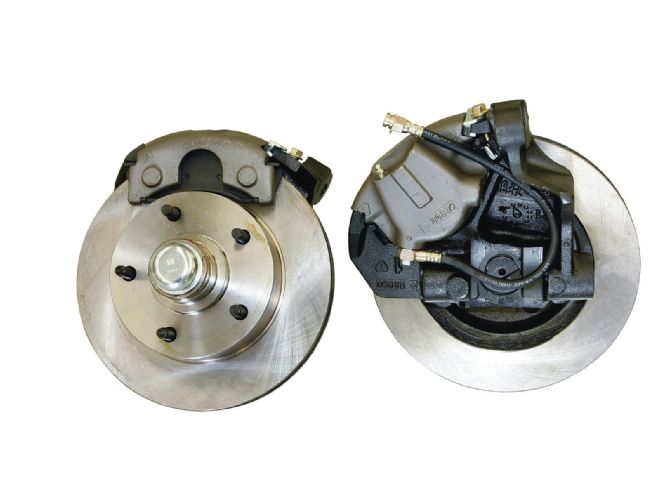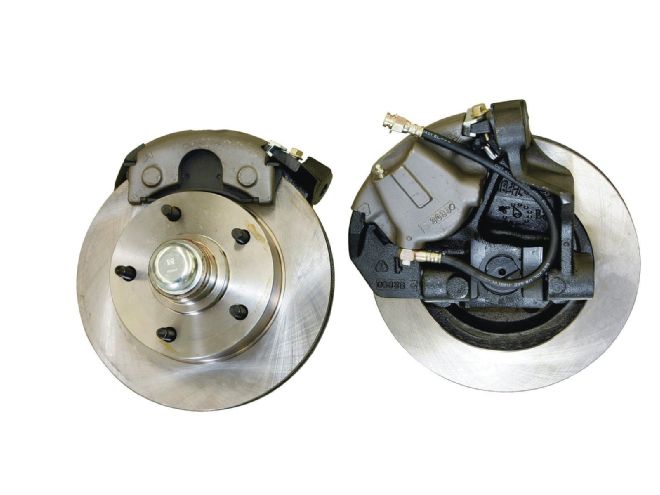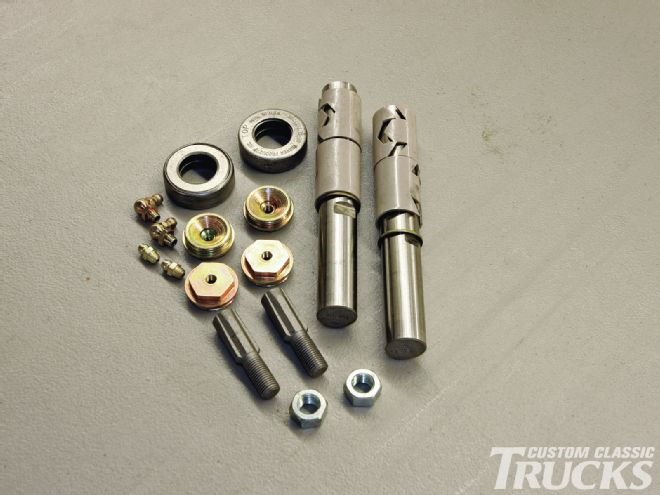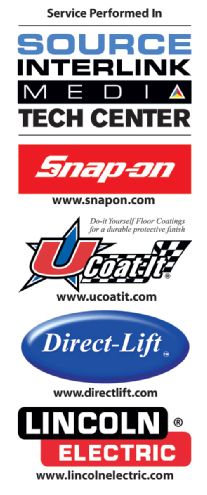
There’s really no excuse to be driving around on today’s highways with 40-plus-year-old drum brakes. I’m sure the design worked fine driving around on the farm or around town at 35 mph, but the majority of our driving duties have changed over the years, as have those around us. In the mid ’60s, most of the cars on the road had drum brakes still and drivers drove their cars accordingly. Today, with most cars featuring advanced braking and suspension designs of some sort, to be the only vehicle on the road with antiquated braking has you at a significant disadvantage.
 Here’s the kit as it comes straight from LMC Truck. Based on reproduction 1973-79 Ford pickup parts, it’s completely assembled and ready to mate to each axle.
Here’s the kit as it comes straight from LMC Truck. Based on reproduction 1973-79 Ford pickup parts, it’s completely assembled and ready to mate to each axle.
So then why do it? There are a number of excuses one can come up with when it comes to why they haven’t made the upgrade and you’re likely to hear a comment or two of how “it worked fine back then,” but things change. We don’t shoot rolls of film and type out these stories on typewriters even though that probably worked fine back then, too. Hop on any highway across the country and if you’re not maintaining the minimum speed limit, you’re likely to get run over by an 18-wheeler. Our trucks need to keep up with the changing environment just like everything else. And one of those changes comes by way of upgrades to the suspension and braking system. Safety should be at the forefront of the upgrades that we make. Brakes that fade during heavy use, are susceptible to failure in wet conditions, and have a tendency to pull, lock up, or otherwise react unreliably should be replaced before any aesthetic modifications are made.
And so, that was the logic when I contacted the gang over at LMC Truck to talk about brake upgrades for ’69 Ford trucks. Our buddy Danny Valenzuela’s been driving his ’69 Ford F-100 across the Los Angeles basin for the past year or so commuting to work, running errands, and picking up his daughter from school. We got to talking about some of the upgrades he wanted to make to his pickup and we both decided that the brakes should be the first on that list. With LMC Truck’s kit in hand, we got Danny to swing the ’69 by the shop so we could bring it up to speed.
The install went together pretty smoothly, but there are a few things that should be pointed out that I didn’t take into consideration beforehand. One, assume that the axles are going to need to be removed from the truck to press out the kingpins. Doing so requires, for all intents and purposes, the removal of the entire front suspension. Take the time and replace all the bushings while you’ve got these things disassembled. I didn’t and wish I had, although the truck will be getting lowered at some point in time, so we’ll be revisiting the components sooner than later. Two, check out the steering components as well so that you can replace those while you’re at it. Worn tie rods, whether on the center link, drag link, or the inner tie rod, should be replaced; now is the time. Lastly, if you’re truck is as greasy and grimy as Danny’s, do yourself a favor and hit it with some degreaser and a pressure washer, you’ll be thanking yourself later.
 To do so requires removing the kingpin assembly for both axles and replacing them with new ones. Thankfully, LMC offers a kingpin kit that consists of new kingpins, bushings, bearings, dust caps, and locking bolts to handle this job.
To do so requires removing the kingpin assembly for both axles and replacing them with new ones. Thankfully, LMC offers a kingpin kit that consists of new kingpins, bushings, bearings, dust caps, and locking bolts to handle this job.
While the Ford twin I-beam design with its kingpins does involve a bit of extra labor when compared to a similar brake swap on a Chevy truck, we had the truck up and running, bled and all, in two days’ time. That makes for a perfect weekend upgrade to that daily driver you’ve been putting off.
Since Danny had been driving the truck around for as long as he had, I assumed that the drum brakes must be working better than I would expect. I was nervously amused, however, when I stepped on the brake approaching the street from the parking lot and didn’t feel that sudden deceleration that one expects when said pedal is applied. Instead, I kept on rolling toward the street, directly in the path of an oncoming vehicle. A quick, anxious jab of the brake pedal got the truck stopped, however, and I laughed out loud, quickly reminding myself that I was driving a 4,000-pound truck with drum brakes that I wasn’t used to.

Since completing the upgrade, I asked Danny how the truck handles, then and now.
“Before when I would hit the brakes on the freeway, I would never know which direction it would decide to head as one brake overpowered the other. It was a constant struggle to keep the truck heading in straight line. Now, you simply mash the brake pedal and it comes to a swift, straight stop. A light amount of pressure on the pedal is all it takes to keep it from creeping at a stop sign as well, so that’s a great improvement to my daily commute.”
Nothing beats a little personal testimonial, eh?! CCT